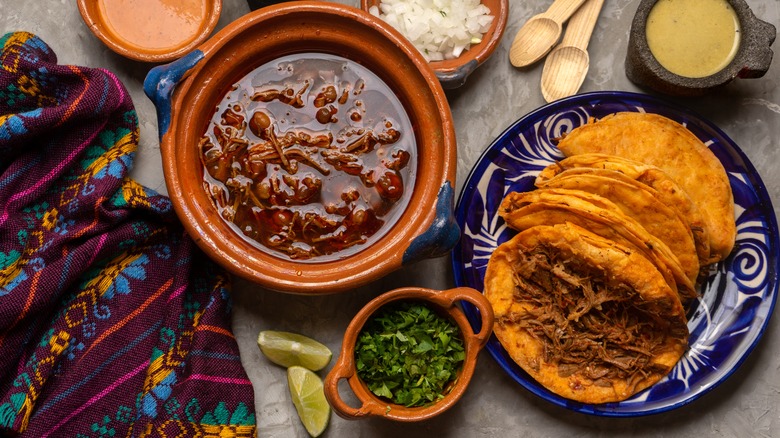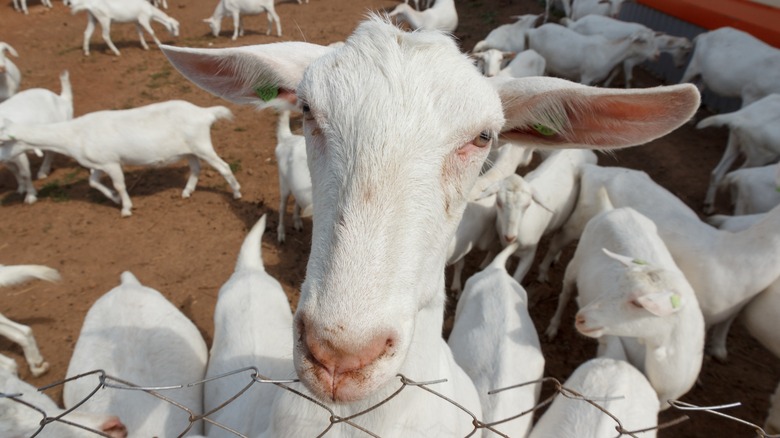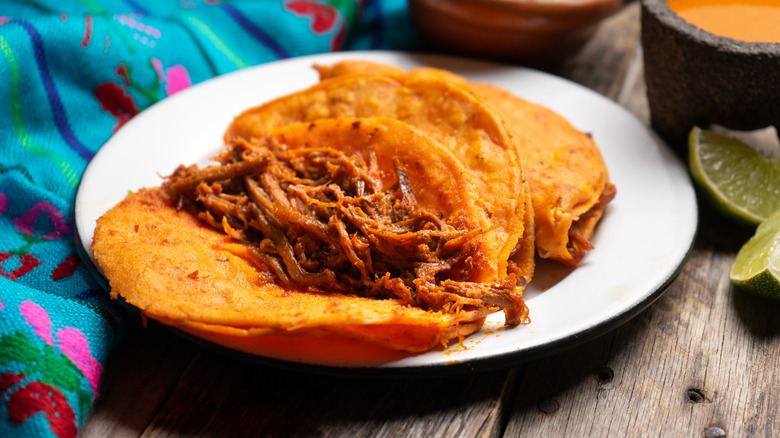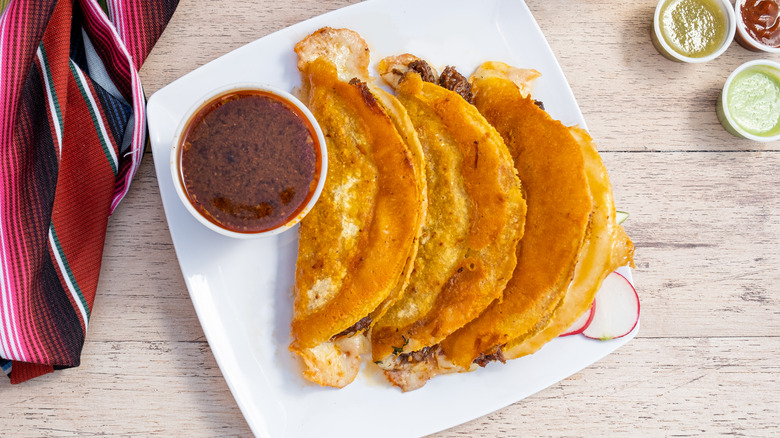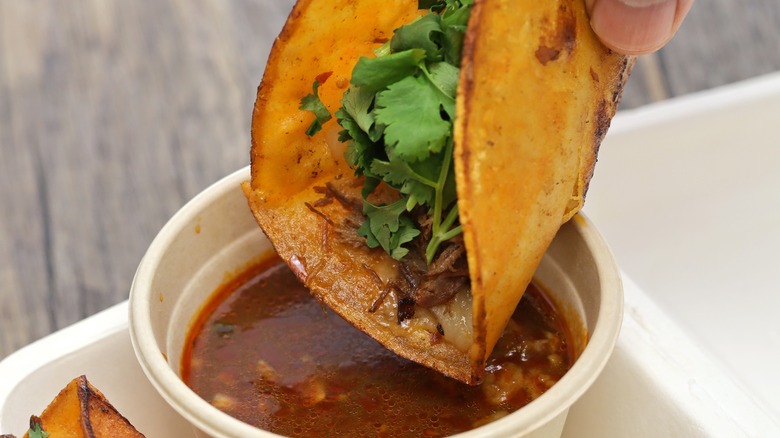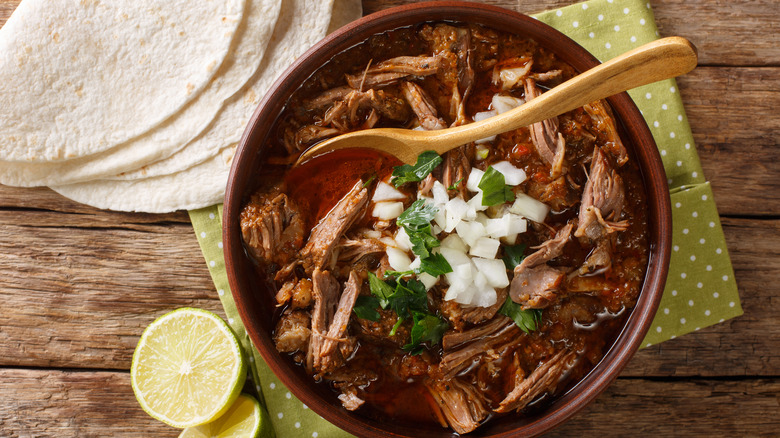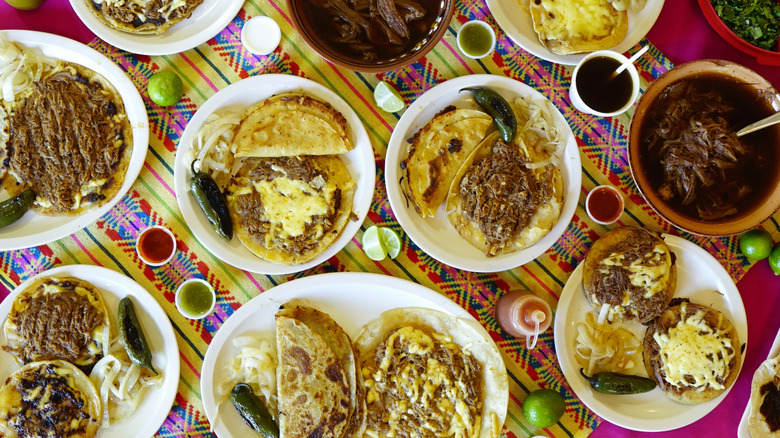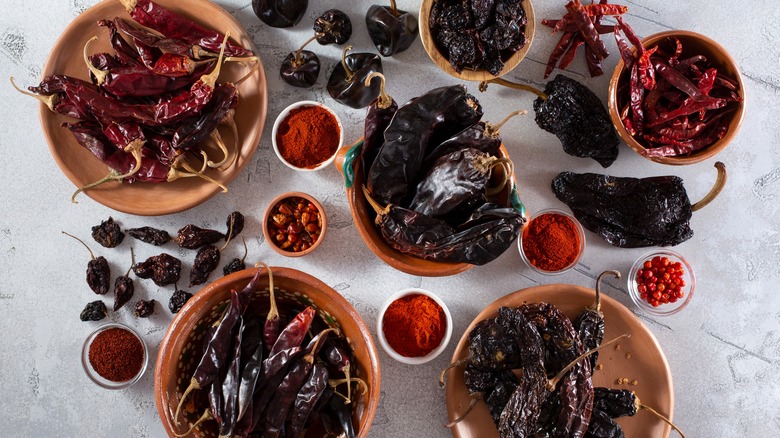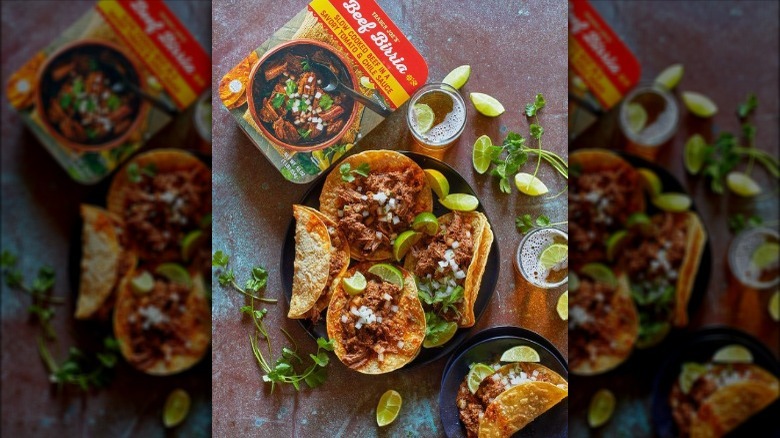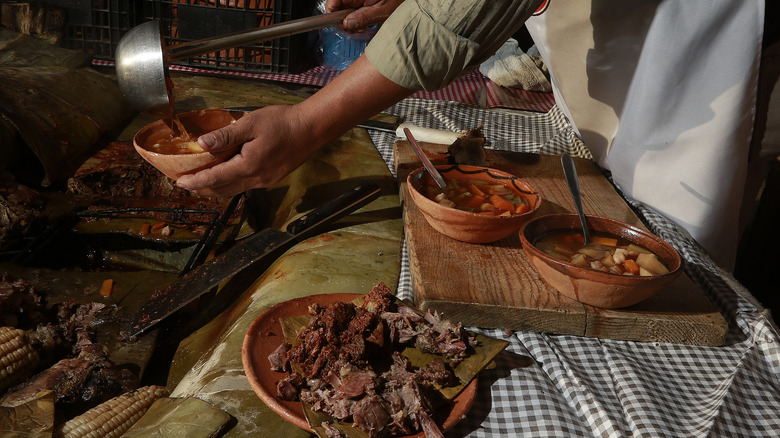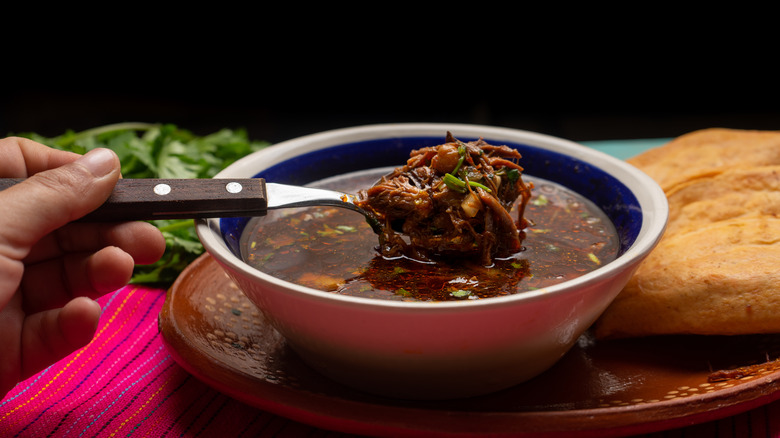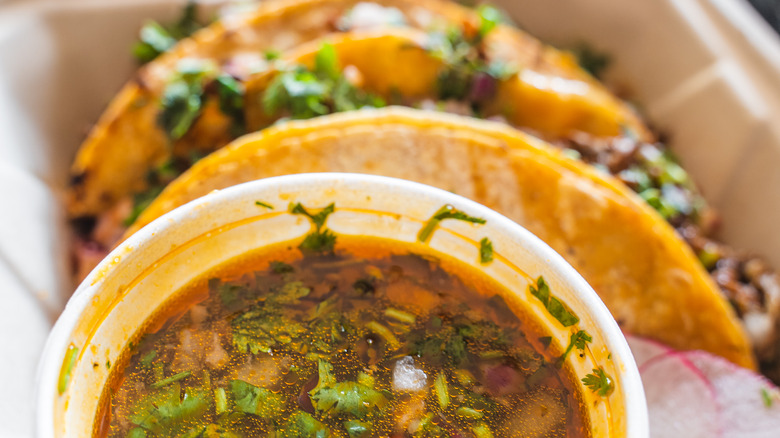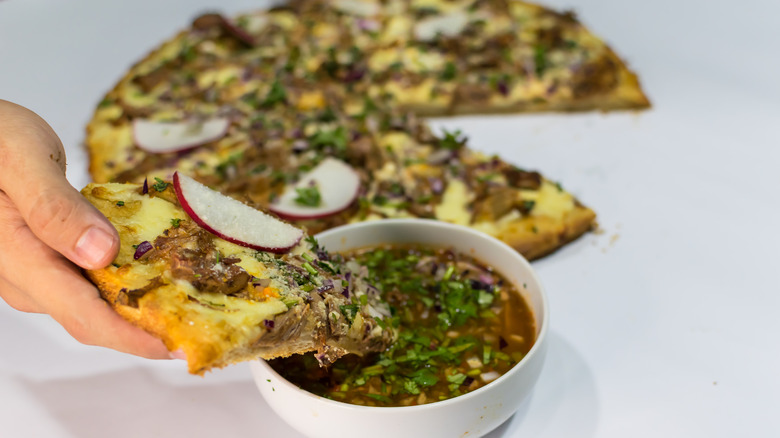The Untold Truth Of Birria
During the onset of the COVID-19 pandemic in 2020, the collective community on social found a lot of comfort in birria. If you aren't familiar with birria, you've likely seen a version of it on your feed at some point. The typical post includes a crispy red taco shell stuffed with slow-cooked meat that is dipped in fatty consomé. Sometimes, it's accompanied by a mouth-watering cheese pull that makes you want to look up the closest spot to get your own ASAP. The dish hails from Mexico, and has undergone quite a transformation from its humble origins to viral popularity. Not only do recipes vary from person to person, but the craze had led to inventive mashups of the Mexican comfort food with other popular menu items.
Birria is so much more than eye-catching photos of tacos that make your stomach grumble. The history of the dish is important to acknowledge as well as its cultural significance. Mashed decided to do a deep-dive into everything you might've not known about birria, so you can be as knowledgable as possible next time you hit up a taco spot, but there's even more you need to know about this delightful cuisine. Here's its untold truth.
Birria was born out of an abundance of goats
Birria in the U.S. is typically made out of beef, but the process of slow-braising in broth can be done with any meat. In particular, birria is historically made using goat meat. Spanish conquistadors brought a variety of livestock to North America, including pigs, chickens, and goats. The goats, however, ended up causing more trouble than they were worth in native Mexico. The goats bred quickly and devastated crops, leading to famine (via Vallarta Eats).
The solution was to start using goats as a food source, which wasn't popular with Spaniards. Goat meat can be gamey and tough, so the native Mexicans cooked it in the ground with herbs and spices to make it tender and more flavorful (via La Autentica). "Birria is one of the crown jewels of the state of Jalisco and represents the melting pot of Mexico between the indigenous ingredients and what the Spaniards brought over," Chef Aarón Sánchez said to Thrillist. It was a widely-available protein source that is still a popular pick for traditional birria today, even if beef is more common in America and other places.
Beef birria comes from Tijuana
Beef birria, known as birria de res, has roots in Tijuana. Many different areas of Mexico have their own styles of birria, but the beef boom is definitely a Northern Mexican creation. In the 1950s, goat meat reportedly became more expensive in Tijuana, so beef was a natural alternative (via Food Network). Additionally, to avoid burning, more liquid was added to the beef braise to make it more of a rich stew. Today, Tijuana-style birria features beef brisket (or another fatty cut), beef fat, adobo, and a lot of water. It is typically served as a stew and comes with onions, cilantro, red salsa, and tortillas (via Eater).
Now, you can find birria in unexpected corners of the U.S. and beyond, even though Californians caught onto the delicious meal sooner thanks to their close proximity to Mexico. It went from being a food traditionally eaten by Mexican-Americans to a food trend that affected Los Angeles and the rest of the world (via LAist).
The cheesy birria tacos are an Americanized version
As previously mentioned, you can find birria across the U.S. With the growing popularity has come an evolution of recipes, and we're not even talking about all of the birria cuisine mashups yet. It's almost more common to find quesabirria on menus in the U.S. instead of the traditional birria stew, even if it's labeled as just birria. The cheesy options are catered toward American diners, unlike the Mexican classic that centers on the beef. It's easy to find quesabirria in nearly every major city, from Kansas City to Tampa, while the traditional birria might be tougher to find in areas with small populations of Mexicans (via Feast Magazine and Tampa Magazine).
Particularly during the pandemic, the widespread public interest in birria tacos helped some food businesses make money in a time of economic trouble. One Chicago taco truck called Flo's Kitchen was struggling during the pandemic, as they rely on the bar and nightlife crowd for the majority of their business. They added birria to the menu, and customers came from far and wide. "When I started, I was cooking one goat a week," owner Florentino Gutierrez said to the Chicago Tribune, "But then it became so popular I needed five goats." Gutierrez's story is just one of many of restaurants benefitting from the birria boom in times of trouble.
Birria exploded on social media
Birria truly transformed from a humble food invented out of need to one of the must-try dishes today. There's a staunch difference between birria stew made with goat meat and a quesabirria popular on Instagram. It's easy to understand the confusion considering the popularity of high-contrast photos of cheesy tacos dipped in cosumé that spread like wild fire over social media. When looking up the hashtag for birria on TikTok, there are videos with an unfathomable 1.9 billion views and counting. Not only will you see people recommending recipes and their favorite spots, but they also experiment with other iterations of the dish to really express their love for it.
TikTok may be a hub for all things birria, but it's made its way to other social media outlets, such as the hundreds of thousands of Instagram posts including the #birria tag. "Sometimes, customers don't even know what it's called, they're just showing me photos on their phones," Baltimore food truck owner Jimmy Longoria told Feed The Malik.
You can make it with nearly any meat
Birria made out of goat and beef may be the norm, but you can really slow-braise any meat with aromatics, spices, and a lot of liquid to make different versions. Sure, it's not customary, but it doesn't mean it's not delicious and a great way to get creative with the dish. For example, The Grub Works Kitchen on Instagram shared a recipe for turkey birria made out of a leftover turkey leg. The recipe features a variety of dried chilis, cinnamon, thyme, tomatoes, and more. It's easy to imagine doing the same with other poultry like chicken or even duck if you have it.
Additionally, pork is another simple swap that yields similarly delicious results. Reddit user u/newyawka_calexito posted their recipe using a pork shoulder, which took 6 hours total to make, with a massive side of consomé fit for dipping tacos, quesabirrias, and anything else your heart desires.
And no two recipes are exactly the same
That is to say, there are dozens of ways to make birria. Traditionally, it was cooked low and slow in an oven in the ground in Jalisco. However, that's not exactly an easy feat for someone living in a studio apartment. If you want to enjoy the flavors of birria, there are many ways to do so both in your own kitchen and in various food establishments. At Mashed, we have a pretty foolproof recipe for Instant Pot birria that's a must-try. You can make it on the stove, in a smoker, or even if a crockpot if that's more of your thing.
The ingredients for each recipe you reference also tend to differ. Some recipes, like Mxriyum on Instagram, feature a chuck roast, chiles, ginger, cumin, vinegar, and tomatoes, among other additions. Others, like Kitchen Uproar on Instagram, do it taco-truck style by dipping the tortillas in consomé and frying them on the grill.
Except one ingredient is key
It is pretty mutually agreed that chiles, particularly dried guajillos, are key to birria. Some people like to use a blend, while others keep it simple with one variety. The chiles are not only important to develop that beautiful bright red color, but to infuse a spicy smokiness into the meat. Guajillos have a medium heat and slight sweetness, which is the key pairing to the fatty beef. It's different than an ancho chile, which tastes earthy while guajillos are slightly fruity. However, it's not uncommon to see the two popular chiles paired together for a complex flavor explosion (via Leite's Culinaria).
"The only constant is the guajillo," Esteban Castillo, a chef and author, said to The Washington Post. "You can make it with other chiles, but it won't be the same." It doesn't matter if you add a cinnamon stick or forgo tomato sauce, but if you don't have chiles, you probably don't have real birria.
Birria is sold at fast food restaurants and the frozen aisle
Whenever certain food trends become popular, it's only a matter of time until someone figures out to make a version that's cheap and easily accesible. Birria may take hours to slow cook, but Trader Joe's created its own frozen beef birria with dried chiles, spices, and crushed tomatoes that comes together in minutes. The grocery store chain markets it for its customers looking for all the flavor without taking all of the time, which is a sentiment we all can probably relate to (via Trader Joe's).
If you were looking for an even more convenient way enjoy birria, El Pollo Loco made it possible to get through the drive-through. The fast-food chain sold beef birria entrees for a limited time, but they were more similar to quesabirria because they all contained cheese. El Pollo Loco sold quesadillas, burritos, and crunchy tacos with the tender meat filling cooked in consomé for those looking for a taste of what the birria hype is all about.
There is a difference between birria and barbacoa
Taco lovers may be curious as to what's so different between birria and barbacoa. It's a good question because at first glance, it's not immediately clear. Essentially, barbacoa describes the way the meat is cooked. It classically entails digging a hole, putting hot stones at the bottom, and putting in meat wrapped in leaves to cook slowly.
If it sounds familiar, it's because it's basically the same way birria was made in Jalisco when the natives had too many goats running around. As for the average diner, they can notice the difference because birria is usually cooked in large amounts of liquid in a pot, whereas barbacoa is typically served as meat with a side of consumé soup (via Eat Mex City).
Again, in the U.S., there might be a more recognizable difference between birria and barbacoa, since quesabirrias dipped in styrofoam cups of broth are so popular. It's important to know the contrast to appreciate the two similar, yet distinct forms of Mexican cuisine staples.
Birria is originally a stew, not tacos
With all of the birria hype, the demand among American consumers seems to be for the taco iterations of the dish. However, the traditional way to eat it is more of a stew. The stew is commonly served with tortillas on the side, so you can make your own tacos on the plate, but it's very different than most of the Instagram-famous versions. The stew is seen as a warm dish for cold days, with hearty meat and a nutritious concentrated consomé. In the 1940s, it wasn't uncommon for the Indigenous population to cook an entire sheep or goat for long hours to warm up (via New York Times).
Additionally, considering the time-consuming nature of the stew, it's typically a dish served at special occasions in Mexico like baptisms, holidays, and quinceañeras (via Amigo Foods). In fact, some birrerias in America still advertise the dish as part of a celebratory meal, such as Rollies Mexican Patio in Tucson, Arizona. They sell a "quinceañera plate" featuring birria, rice, beans, macaroni salad, and a tortilla to scoop it up with (via Rollies Mexican Patio/Instagram).
And it's traditionally eaten for breakfast (and as a hangover cure)
As birria spread throughout Mexico, particularly in Tijuana when birria de res was born, it was typically eaten as a breakfast food. Remember how we mentioned it was a special occassion meal? Well, it's also a hearty hangover cure after a night of drinking (via Vallarta Eats). Washington D.C. restauranteur Geraldine Mendoza explained to Feed The Malik that the cheesy tacos we know today are an iteration of a staple stew. "Birria was traditionally served as a soup and was said to be good as a hangover cure," Mendoza said.
Birria is the ultimate day-after brunch food, considering it has spices, fat, and filling carbs, especially when served with a tall pile of warm tortillas. It's not the traditional bacon, egg, and pancakes you might find in America, but it sure is a filling and flavorful way to start your day, whether you're hungover or not.
People have gotten creative with different renditions of it
Whenever a food becomes popular, people seem to instantly try to find ways to make an inventive new version of it. Birria is not unusual. Birria tacos and quesadillas got the larger population interested with the luscious meat, but it didn't take long for restauranteurs and food enthusiasts to try to find new ways to eat it on everything. La Birria Pizza is a Los Angeles fushion restaurant that makes various pies topped with birria (as well as versions featuring carne asada and al pastor). Palapas Tacos in Fullerton, California floods Instagram with photos of their birria ramen combination, which is another popular mash-up.
One Reddit user u/whoooomst got creative with leftover birria and sautéed it into a gnocchi pasta dish. Additionally, The Varied Table on Instagram shared an amazing recipe featuring birria meat on garlic buns for succulent sliders for a crowd.
